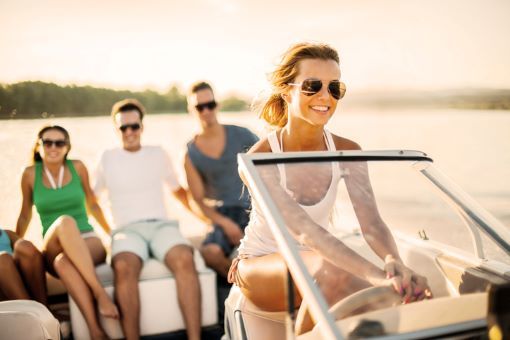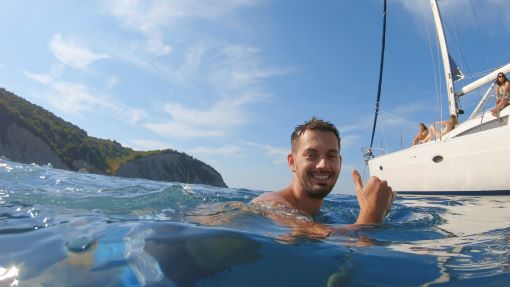Boating is one of the most enjoyable outdoor activities for those who love connecting with nature. It’s a versatile blend of relaxation and adventure – and a chance to connect with loved ones. However, new boaters and guests may not know safety basics like how to sit and swim safely while boating. Let’s go over these foundational safety guidelines.
The Importance of Wearing Life Jackets
First, wearing a life jacket is non-negotiable. Life jackets are the single most important piece of safety equipment on a boat. They can be the difference between life and death in an emergency. Here's how to choose the right life jacket:
- Fit and Comfort: wear a life jacket that fits snugly but comfortably. It shouldn't restrict your movement or breathing.
- Type and Use: Different life jackets are designed for different activities. Make sure you choose one that is suitable specifically for boating.
- For Everyone: Every passenger, regardless of swimming ability, should have a life jacket.
How to Sit Safely on a Boat
Sitting safely on a boat sounds simple, but it’s a critical safety practice - especially when the boat is moving:
- Bow and Gunwales: Sitting on the tip of the bow (front) or gunwales (sides) rather than in designated seating while the boat is moving can be extremely dangerous. These areas are not designed for sitting and pose a high risk of falling overboard.
- Designated Seating: Always sit in designated seating areas. These spots are specifically designed to provide safety and stability.
- Hold On: Always hold onto something stable, like a railing or a sturdy part of the boat, especially when the boat is in motion or if the water is choppy.
- Stay Seated: Avoid standing up or moving around when in motion - even at slow speeds. Sudden movements can cause you to lose balance and fall.
How to Swim Safely Near Boats
Swimming near a boat is a refreshing way to spend an afternoon, but it comes with its own risks. Here’s how to swim safely near boats:
- Turn Off the Engine: Always confirm that the boat's engine is turned off before anyone gets into the water. This prevents accidental and serious injuries from the propeller.
- Avoid the Propeller: Never swim near the boat's engine or propeller, even when it's off. Accidents can happen if the engine is accidentally started.
- Stay Close: Always swim within sight of the boat. Choose a designated person to always keep an eye on those swimming to prevent accidents.
- Use a Swim Ladder: Re-entering the boat can be tricky. Always use a swim ladder to get back on board safely.
The Role of a Designated Watcher
Having a designated watcher is crucial for swimmer safety. This person is responsible for keeping an eye on everyone in the water and alerting others in case of emergencies.
The designated watcher should constantly monitor the swimmers, especially children or less experienced swimmers. In case of an emergency, the watcher should be ready to act quickly, whether it’s to provide assistance or call for help.
Additional Safety Tips for Boat Passengers
Beyond sitting and swimming safely, there are other essential safety practices to follow:
Understand Boat Safety Basics
- Learn the Basics: All passengers should be familiar with basic boating safety rules and emergency procedures.
- Emergency Plan: Know what to do in case of an emergency, including how to use the boat's safety equipment and who to call for help.
Prepare And Plan Ahead
- Weather Changes: Be prepared for sudden changes in weather. Always check the forecast before heading out and have a plan for unexpected storms.
- Pre-Departure Checklist: Create and follow a pre-departure checklist to ensure you have all necessary equipment and safety gear on board.
- Inform Someone of Your Trip: Always let a friend or family member know your boating plans.
- Regular Maintenance: Keep your boat in good working condition with regular maintenance checks on the engine, hull, electrical systems, and safety equipment.
While On the Water
- Proper Loading: Distribute weight evenly on the boat to maintain balance and stability. Overloading the boat can make it susceptible to capsizing.
- Secure Loose Items: Secure all loose items on the boat so they won’t become dangerous during sudden movements or rough waters.
- Safety Briefing: Go over a quick safety briefing for all passengers before departure, outlining safety procedures, the location of safety equipment, and what to do in an emergency.
- Stay Hydrated: Boating can be surprisingly dehydrating, especially in the sun. Encourage everyone on board to drink plenty of water and protect yourself from sun exposure with hats, sunglasses, and sunscreen.
- Anchoring: Learn proper anchoring techniques to ensure the boat stays in place, especially in strong currents or windy conditions.
Staying Safe While Boating
Boating is a wonderful way to spend time on the water, but safety should always be the top priority. By following these guidelines, you can have a safer experience for everyone on board. For more detailed boating safety tips, visit Discover Boating.
This article and video are sponsored by Progressive Insurance®



